Sony NS3100, DVP-NS9100ES User Manual
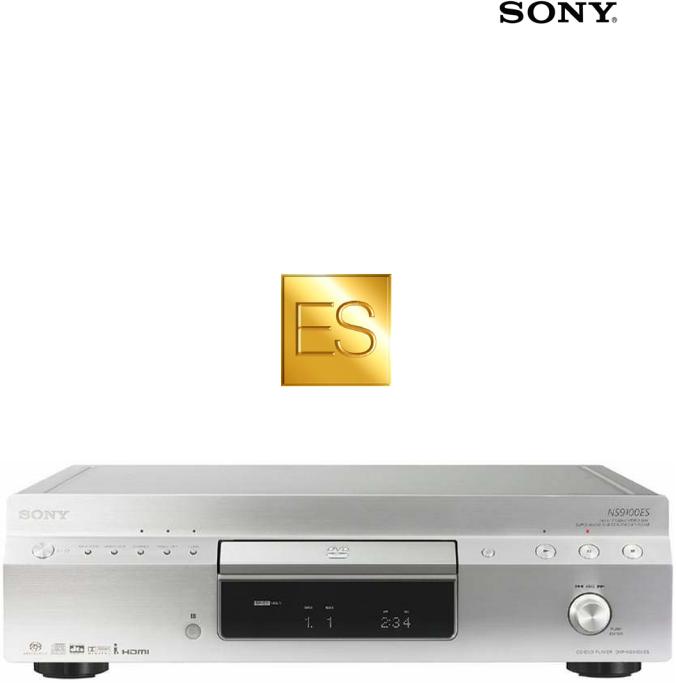
ES DVD Players
Technical Background
Version 4.0; August 8, 2005
Introduction
Sony ES engineers are superbly educated, exceptionally well equipped and have ready access to world-leading in-house technologies. But these alone do not explain the soul of Sony's ES Series. You see, the creators of these components are motivated by their passion for music and movies. That's what drives them late into the night, seeking to control visual artifacts that most viewers will never notice. That's what takes them into the listening room, seeking to identify subtle sonic differences among various converters, capacitors and equipment interfaces. The result is an Elevated Standard in DVD/Super Audio CD/CD players. Presenting the DVP-NS9100ES and DVP-NS3100ES.
Sony co-developed the Compact Disc, Super Audio CD and DVD. Our knowledge of these formats is encyclopedic. And Sony's expertise is clearly evident in these latest players. They represent superb craftsmanship and state- of-the-art electronic design. But there's more. The two models provide stunning, upscaled High Definition images, using the HDMI interface. And the NS9100ES is Sony's first DVD player to incorporate an i.LINK® (IEEE 1394) digital output for Super Audio CD signals1.
i.LINK® and HDMI™ Digital Interfaces1................. |
Page 3 |
Video Performance................................................. |
Page 11 |
Audio Performance................................................. |
Page 28 |
Construction & Design............................................ |
Page 39 |
Features.................................................................. |
Page 42 |
Specifications.......................................................... |
Page 44 |
1.i.LINK is a trademark of Sony used only to designate that product contains an IEEE 1394 connector. All products with an IEEE 1394 connector may not communicate with each other. Please refer to the documentation that comes with the device having an i.LINK connector for information on compatibility, operating conditions and proper connection.
ES DVD Players 2005, Version 4.0 |
Page 2 |
i.LINK® and HDMI™ Digital Interfaces
In 1985, the engineers of Sony® ES surprised the world of high fidelity. The Sony CDP-650ES was the world's first CD transport with a digital output, enabling unheard-of sound quality and unprecedented flexibility in audio system configuration. Now such interfaces are taken for granted in high fidelity.
In 1997, Sony staged another coup with the DCR-VX1000 Handycam® camcorder, the world's first video component to incorporate IEEE 1394, called the i.LINK® interface by Sony. Now such interfaces are found on almost every digital camcorder and millions of personal computers.
In 2003, Sony took the i.LINK interface in an entirely new direction with the SCD-XA9000ES Super Audio CD/CD player. It was Sony's first to use the i.LINK interface to carry an uncompressed digital output for the Super Audio CD's Direct
Stream Digital® signal.
Today, Sony takes digital interfaces one step further. The DVPNS9100ES is Sony's first DVD/Super Audio CD/CD1 player to incorporate the i.LINK digital audio output. While both the NS9100ES and the NS3100ES incorporate a High Definition HDMI digital output that unifies both video and multi-channel audio! These are the most advanced digital interfaces Sony has ever built into a home A/V source component.
i.LINK Digital Audio Output (NS9100ES)
From the initial launch of Super Audio CD, the 1-bit DSD® pulse train was always converted to analog prior to output. This means that previous DVD players with Super Audio CD capability could only output the SA-CD sound in analog, not digital, even if the player included coaxial and optical digital outputs.
1.i.LINK is a trademark of Sony used only to designate that product contains an IEEE 1394 connector. All products with an IEEE 1394 connector may not communicate with each other. Please refer to the documentation that comes with the device having an i.LINK connector for information on compatibility, operating conditions and proper connection.
ES DVD Players 2005, Version 4.0 |
Page 3 |
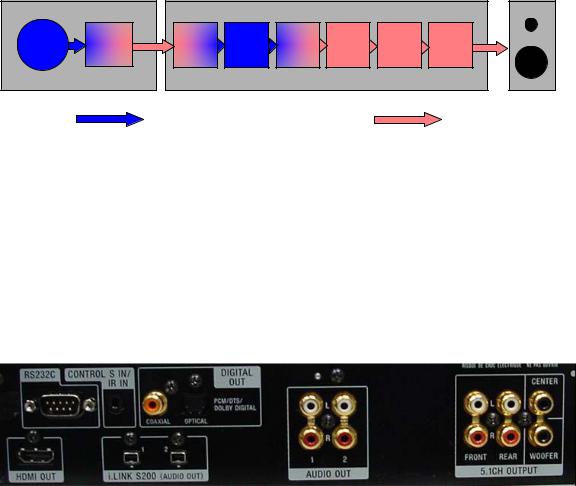
SA-CD Player |
Amplifier |
Speakers |
SA-CD |
D/A |
|
convert |
||
|
A/D |
DSP |
D/A |
LPF |
Volume |
Analog |
|
Power |
||||||
convert |
convert |
|||||
|
|
|||||
|
|
|
|
|
Amp |
Digital Signal |
Analog Signal |
Typical SA-CD reproduction involves numerous D/A and A/D conversions. The i.LINK digital connection can simplify the signal path.
However, these analog connections can expose the Super Audio CD signal to repeated D/A and A/D conversions. The i.LINK® interface of the DVP-
NS9100ES overcomes this limitation. The i.LINK interface maintains the signal in the digital domain, protecting the music from repeated conversions. This i.LINK digital output is compatible with the i.LINK digital input on Sony's own STR-DA7100ES and the recent STR-DA9000ES. The i.LINK interface also enables a single digital cable to take the place of six analog cables.
A portion of the DVP-NS9100ES back panel shows the multi-channel analog outputs (lower right), stereo analog outputs (center), optical and coaxial digital outputs for DVD and CD (upper left) and i.LINK digital output for Super Audio CD (lower left).
ES DVD Players 2005, Version 4.0 |
Page 4 |

|
|
4 |
|
|
|
|
|
|
|
|
|
|
|
|
|
|
|
|
|
|
|
|
|
|
2 |
|
|
3 |
|
|
|
|
1 |
|
|
|
|
|
|
||
|
|
|
|
|
||
|
|
|
|
|
|
|
Internal layout of the DVP-NS9100ES as seen from the back. You can see the edge of one of the R-Core power transformers (1), the analog audio circuit (2), and the analog video circuits (3). The digital audio circuit board (4), which includes and the i.LINK output is partially hidden behind the analog video circuit.
The i.LINK® digital audio interface uses Digital Transmission Content
Protection (DTCP), a robust system that protects the music from piracy. The application of the i.LINK (IEEE 1394) interface for Super Audio CD is clearly different from—and not compatible with—previous i.LINK interface applications for DV camcorders, PC peripherals and professional digital video systems. You can only connect the DVP-NS9100ES i.LINK output to a compatible digital audio input, such as that on the STR-DA7100ES receiver.
The i.LINK output circuit incorporates this Large Scale Integrated circuit from Texas Instruments.
ES DVD Players 2005, Version 4.0 |
Page 5 |

High quality digital Audio
Transmission System (HATS)
The design of the i.LINK® interface is exceptional because communicating six streams of 2.8224 MHz digital samples raises extreme challenges. Conveying 1-bit signals at such high data rates and synchronizing the signals with the other component's master clock would normally expose the signal to the time-base errors called jitter. These errors translate directly into time-based distortion of the audio waveform.
The connection from the DVP-NS9100ES to the STR-DA7100ES receiver overcomes this challenge with the High quality digital Audio Transmission System (HATS). HATS uses "command-based rate control of isochronous data flow" to solve the problem. The system incorporates three principal elements.
1.Variable-speed transmission from the player.
2.Buffer memory in the receiver.
3.Command signals from the receiver to the player, controlling transmission speed.
The receiver continually monitors the amount of audio data in its buffer memory. When the buffer memory reaches its lower limit, the receiver commands the player to increase data transmission speed. When the buffer memory reaches its upper limit, the receiver commands the player to decrease transmission speed. And when the buffer memory is between the upper and lower limits, the receiver commands the player to transmit at normal speed.
DVP-NS9100ES |
|
STR-DA7100ES |
|
|
|
With Sony® HATS, audio data flows from the player to the receiver's buffer memory, according to rate control commands from the receiver. Reproduction in the receiver achieves the full time base accuracy of the receiver's quartz crystal master clock.
In this way, HATS makes it unnecessary to synchronize a jitter-prone signal with the receiver master clock. Instead, the buffer memory outputs a jitter-
ES DVD Players 2005, Version 4.0 |
Page 6 |
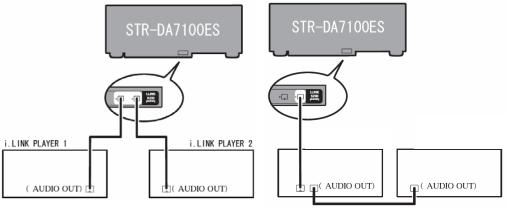
free signal at the full quartz-crystal accuracy of the receiver's master clock. You get all the benefits of digital transmission, without exposing the signal to the potential for jitter-induced distortion.
Dual i.LINK® interfaces
The DVP-NS9100ES actually has two i.LINK® interfaces in daisy chain configuration.1 You can connect a second i.LINK source component to the DVP-
NS9100ES, while the NS9100ES itself connects to a single i.LINK interface port on the STR-DA7100ES A/V receiver. In this configuration, all three i.LINK components must be switched on for the second source component to transfer signals to the STR-DA7100ES. Performance is only guaranteed when the second source component is a Sony SCD-XA9000ES or another DVP-
NS9100ES and the A/V receiver is an STR-DA7100ES.
SCD-XA9000ES or
DVP-NS9100ES DVP-NS9100ES
Thanks to the daisy chain architecture of the i.LINK interface, it is possible to connect components in different configurations. However, performance for the daisy chain on the right is only guaranteed when connecting the Sony equipment shown.
1.i.LINK is a trademark of Sony used only to designate that product contains an IEEE 1394 connector. All products with an IEEE 1394 connector may not communicate with each other. Please refer to the documentation that comes with the device having an i.LINK connector for information on compatibility, operating conditions and proper connection.
HD upscaling and the High Definition
Multimedia Interface (HDMI™) technology
Today's home theater enthusiasts are increasingly likely to have "HD Ready" or "HD Built in" televisions. And they're just as likely to be starving for High Definition content. The DVP-NS9100ES and NS3100ES go a step toward fulfilling that need with High Definition upscaling of the Standard Definition DVD signal.
ES DVD Players 2005, Version 4.0 |
Page 7 |
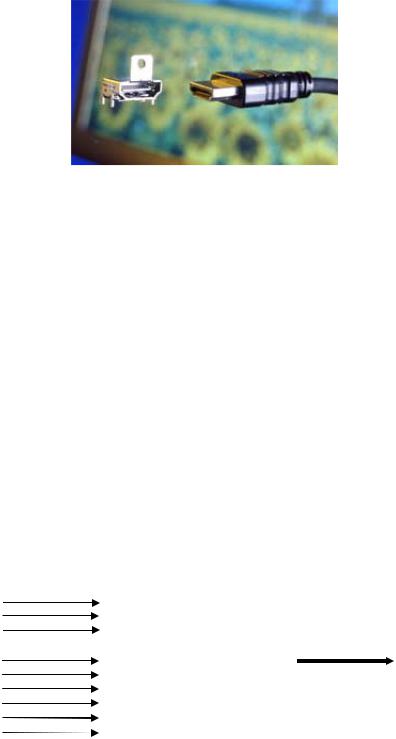
An HDMI™ plug and its corresponding jack.
To begin with, many DVDs originate on film or progressive scanning video.
These discs are encoded in 480p progressive scanning to deliver twice the vertical resolution as conventional 480i video. Sony's HD "upscaling" outputs this signal as 480p, 720p or 1080i High Definition via the High Definition Multimedia
Interface (HDMI™) jack. You owe it to yourself to spend some time admiring the results. Slip in a top-quality DVD, and the upscaled image is sumptuous, rich and detailed. Even though this source material is Standard Definition, it comes amazingly close to the look of full High Definition.
While 480p video is also available at the analog component video outputs,
HD upscaling at 720p and 1080i is only available via the HDMI™ output.
Established in September 2003, HDMI™ is an extension of the DVI digital interface. While DVI is limited to video only, HDMI™ can transmit uncompressed
High Definition digital video and digital audio via a single cable. This greatly simplifies system set-up, replacing as many as ten analog and digital connections with just one cable! In addition to providing 480p, 720p or 1080i, the HDMI output of Sony® ES Series DVD players can support digital signals in both RGB component video and Y/Cb/Cr component video.
|
Y |
|
|
|
|
|
|
Pb |
|
|
|
|
|
|
Pr |
A/V |
|
|
|
A/V |
|
|
|
|
|
||
DVD |
Left |
Receiver |
|
DVD |
HDMI |
Receiver |
Player |
Right |
or |
|
Player |
|
or |
|
Television |
|
|
|
Television |
|
|
Center |
|
|
|
||
|
|
|
|
|
|
|
|
Surround Right |
|
|
|
|
|
|
Surround Left |
|
|
|
|
|
|
Subwoofer |
|
|
|
|
|
|
|
|
|
|
|
|
Before HDMI technology (left), you needed nine cables to get component video and 5.1-channel analog audio from your DVD player and into your receiver. HDMI conveys both video and audio with full resolution and digital precision—all on a single cable!
ES DVD Players 2005, Version 4.0 |
Page 8 |
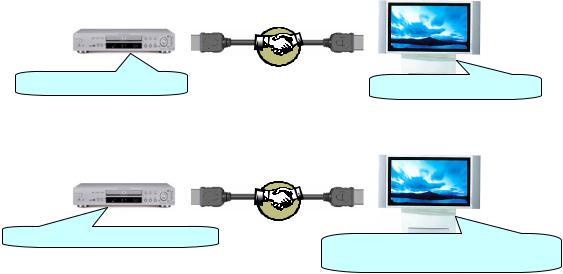
The options for audio are equally rich. The HDMI™ output of Sony® ES
Series players can support a full range of digital audio, including 2-channel stereo PCM, Dolby® Digital and DTS® 5.1-channel compressed audio and even uncompressed multi-channel PCM audio! The DVP-NS9100ES incorporates the awesome capabilities of the Silicon Images Sil9030 Large Scale Integrated Circuit (LSI). Thanks to the Sil9030, the NS9100ES can output uncompressed digital images up to 1080i and uncompressed digital audio up to 192 kHz/2- channel or 96 kHz/8-channel!
With so many choices for video and audio output, you may wonder whether users will be knowledgeable enough to get the best performance from their systems. Is RGB preferable to Y/Cb/Cr? Is 720p better suited to their television or 1080i? While users will have their choice from a menu of options,
HDMI technology offers a simpler way.
Component-to-component communication
A system called “product unique key exchange” enables connected equipment to automatically confirm the type of component connected through the
HDMI cable. In addition, a destination component (such as Sony's STR-
DA7100ES A/V receiver) can automatically "request" the appropriate audio and video, by listing its input capabilities. In this case, the ES Series DVD player can automatically choose the highest performance audio and video formats that the DVD player and the destination component both have in common!
Consider what happens when you connect a DVP-NS9100ES or NS3100ES to an HDMI equipped television. On first connection the two components exchange basic information—they "introduce themselves."
DVP-NS9100ES |
Television |
or NS3100ES |
with HDMI |
|
input |
Hi. I’m a DVD player. |
Hi. I’m a television. |
Next, the components communicate their input/output capabilities.
DVP-NS9100ES or NS3100ES
What is your input capability?
Television with HDMI input
I can accept 720p video and 2- channel audio at 48 kHz and 16 bits.
ES DVD Players 2005, Version 4.0 |
Page 9 |
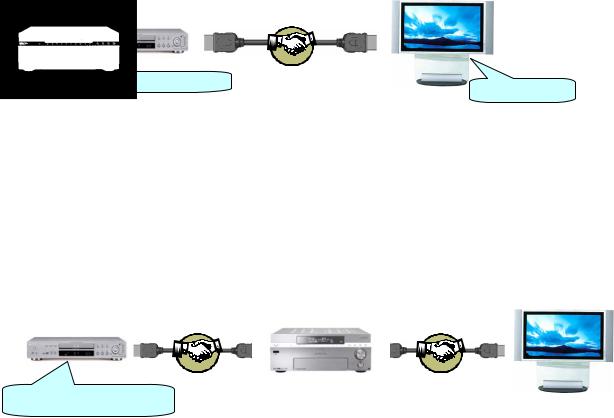
Finally, the components agree on the highest available quality options for digital audio and video—and then automatically transfer content at that quality!
DVP-NS9100ES |
Television |
or NS3100ES |
|
|
with HDMI |
|
input |
OK. I can output those signals. |
Thank you |
|
We've considered just a DVD player and a television. But the dynamic changes when you insert the Sony® STR-DA7100ES A/V receiver into the reproduction chain. In this case, the source component DVD player can only talk to the next component in the chain, the receiver. The receiver then communicates with the television and mediates the content exchange for the entire system.
|
|
Television |
DVP-NS9100ES |
Receiver with |
with HDMI |
or NS3100ES |
HDMI input & |
input |
Receiver, what is your input capability?
Please note that some restrictions apply.
•AC Power. All HDMI components must be switched on in order for the
HDMI system to work. You can't use HDMI connections through the receiver if the receiver is switched off.
•Anti-piracy. To prevent the piracy of very high quality digital signals, HDMI technology also incorporates a security method called High-bandwidth Digital
Content Protection (HDCP). This encrypts the signal so that only authorized devices can decode the data into pictures and sound. The HDMI connection is for playback only, meaning that content distributed via HDMI cable cannot be recorded.
•Super Audio CD. As of January 2005, standards for sending Super Audio
CD sound over HDMI cables had not been established. For this reason, Super Audio CD sound is not available over the HDMI outputs of the DVP-
NS9100ES and NS3100ES.
ES DVD Players 2005, Version 4.0 |
Page 10 |
Video Performance
Precision Cinema Progressive™ circuitry
The purpose of today's high-end home theater systems is to recreate the look and sound of the movie theater. This includes the vivid detail and seamless coherence of the film frame. A crucial technology for achieving this goal is DVD-
Video playback with progressive scanning, "480P" output. This works with many of today's "HD capable" and "HD monitor" televisions, which offer 480P inputs.
For example, Sony markets this capability as a Hi-Scan 1080i™ television. In this context, 480P outputs have been promoted as a must-have feature in DVD players. However, there continue to be important differences in how DVD players generate the 480P signal. The DVP-NS9100ES and NS3100ES have Sony's Precision Cinema Progressive system, a comprehensive approach that incorporates two significant circuits to deliver a picture that comes closer than ever to the original movie theater experience. Sony's Pixel-by-Pixel Active interlace-to-progressive (I/P) conversion ensures maximum resolution, while Sony's Vertical Edge Compensation reduces artifacts along the edges of objects in the scene.
Pixel-by-Pixel Active I/P Conversion
Interlace-to-Progressive (I/P) conversion is a potentially tricky process.
The solutions range from inexpensive and simplistic to sophisticated Hollywood postproduction systems that require powerful computation. Optimum I/P conversion is challenging because there are so many different types of content:
1.Material originated on film (or on 24-frame progressive digital systems, which in this context behave just like film).
2.Material originated on film and recorded onto DVD-R/RW or DVD+R/RW.
3.Material that quickly intercuts video and film-originated footage.
4.Material that has film and video showing at the same time.
5.Material originated on interlaced video.
These different types of DVD material place different demands on the I/P converter. A conversion strategy optimized for material originally shot on film will not get the best results for material originally shot on interlaced video, and vice versa.
ES DVD Players 2005, Version 4.0 |
Page 11 |

The mathematical algorithms of Sony's Pixel-by-Pixel Active I/P conversion have been committed to silicon in this Large Scale Integrated circuit (LSI), the Sony CXD9866R.
Sony solves the problem with Pixel-by-Pixel Active I/P conversion that includes built-in motion detection. The system automatically recognizes each type of material and applies the appropriate processing. This enables us to generate the ideal progressive scanning output for each type of DVD source.
•Film originated material. For footage originally shot on 24-frames per second film and 24-frame progressive digital cameras, simplistic solutions like "frame memory" can end up creating motion artifacts that mar the final result. These appear as zipper-like patterns on the left and right edges of moving objects. The Sony® system automatically and flawlessly detects the 3-2 cadence and performs full "3-2 reverse conversion," which maintains the integrity of the original film frames. Mismatched film frames are never "forcefit" into a single video frame. The system adds no motion blurring. You'll enjoy twice the vertical resolution of conventional interlace video, for an experience that's less like watching television and more like watching film.
•Film originated material on a DVD-R/RW or DVD+R/RW. DVD recorders complicate the I/P conversion processes, because these recorders capture everything as interlaced video. That means movies, even if they were originally shot on film, are recorded as 30 frames per second interlaced, not
24 frames per second progressive. There are none of the usual First Field
Repeat Flags (FFRFs), leaving many DVD players unable to guess at the original frame structure. In this case, conventional 3-2 reverse conversion will not work, but Sony's Pixel-by-Pixel Active I/P conversion will. Thanks to builtin motion detection, the Sony system does not depend on FFRFs. So you get accurate reproduction on DVD-R/RW and DVD+R/RW discs.
•Film material intercut with video material. Sony's Pixel-by-Pixel Active I/P conversion applies appropriate processing for film elements and interlaced video elements, even when they alternate in rapid-fire sequence, as they might during the "making of" documentary on a movie DVD. The Sony system instantly recognizes the characteristics and film and video and automatically applies the correct processing for each.
ES DVD Players 2005, Version 4.0 |
Page 12 |

•Film and video material shown simultaneously. The Sony® system performs beautifully even when film and video appear on-screen at the same time, for example, when video-originated subtitles are superimposed over a film-originated scene. Because the Sony system analyzes each individual pixel, it can switch processing modes anywhere—even in the middle of a scanning line! In contrast, conventional systems need to wait until the end of the field before switching between film and video modes.
•Interlaced video. Shooting on interlaced video means capturing a new field of 240 interlaced scanning lines every 1/60 second. When subjects are moving, there can be significant differences from each field to the next. It's a far cry from film 24 frame progressive origination, where the subjects move each 1/24 second. Combining two video-originated fields of 240 interlaced scanning lines into one frame of 480 progressive scanning lines is no simple task. For this reason, Sony's Pixel-by-Pixel Active I/P conversion applies special processing for video originated material.
In addition, these Sony ES Series DVD players enable you to adjust the threshold of film and video detection. So you can optimize the I/P conversion for the specific DVD you're watching. You get I/P conversion that's not only amazingly smooth, but also exquisitely tuned to the individual needs of each DVD. When you're done watching, the players can store the setting in memory for up to 400 discs. So each time you play that title, you'll automatically get just the right conversion!
An on-screen display enables you to adjust the threshold of film and video detection for each individual disc. Sony players can even store your setting for use the next time you play that title!
ES DVD Players 2005, Version 4.0 |
Page 13 |

Pixel-by-Pixel Active I/P conversion and interlaced video origination
Many of today's DVDs feature concert videos, documentaries, current events, sports, nature footage and other subjects originally captured on interlaced video. For this reason, any high-end progressive scanning system must solve the problem of motion artifacts for footage shot on video. Video based I/P conversion creates new pixels from existing information. For example, to enable progressive scan output for a field of odd scanning lines, the player must create the pixels that compose all the even scanning lines. Unfortunately, this can result in motion blur. Horizontal lines in the scene can flicker on and off.
Other areas can suffer from an unnatural shimmer.
Scanning
lines
EVEN 3 Past |
ODD 2 Past |
EVEN 1 Past |
ODD current |
EVEN future |
Time sequence
I/P conversion of video originated material. The red pixel, on an even scanning line needs to be created for the current field of odd scanning lines. If not done properly, this can result in zipper-like edges on moving objects, line flicker and unnatural shimmering.
Sony's Pixel-by-Pixel Active I/P conversion overcomes these problems with built-in motion detection and two distinct video conversion algorithms: one for still objects, another for moving objects. As with film origination, the algorithms are applied separately for each individual pixel. So both can be applied to different parts of any given scene!
ES DVD Players 2005, Version 4.0 |
Page 14 |
